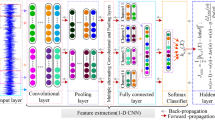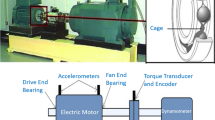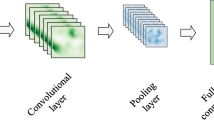Abstract
Deep learning has seen increased application in the data-driven fault diagnosis of manufacturing system components such as rolling bearing. However, deep learning methods often require a large amount of training data. This is a major barrier in particular for bearing datasets whose sizes are generally limited due to the high costs of data acquisition especially for fault scenarios. When small datasets are employed, over-fitting may occur for a deep learning network with many parameters. To tackle this challenge, in this research, we propose a new methodology of parallel convolutional neural network (P-CNN) for bearing fault identification that is capable of feature fusion. Raw vibration signals in the time domain are divided into non-overlapping training data slices, and two different convolutional neural network (CNN) branches are built in parallel to extract features in the time domain and in the time-frequency domain, respectively. Subsequently, in the merged layer, the time-frequency features extracted by continuous wavelet transform (CWT) are fused together with the time-domain features as inputs to the final classifier, thereby enriching feature information and improving network performance. By incorporating empirical feature extraction such as CWT, this proposed method can effectively enable deep learning even with dataset size limitation in practical bearing diagnosis. The algorithm is validated through case studies on publicly accessible experimental rolling bearing datasets. A wide range of dataset sizes is tested with cross-validation, and influencing factors on network performance are discussed. Compared with existing methods, the proposed approach not only possesses higher accuracy but also exhibits better stability and robustness as training dataset sizes and load conditions vary. The concept of feature fusion through P-CNN can be extended to other fault diagnosis applications in manufacturing systems.










Similar content being viewed by others
References
Attoui I, Oudjani B, Boutasseta N, Fergani N, Bouraiou A (2020) Novel predictive features using a wrapper model for rolling bearing fault diagnosis based on vibration signal analysis. Int J Adv Manuf Technol 106:9–12
Wang H, Chen J, Zhou Y, Ni G (2019) Early fault diagnosis of rolling bearing based on noise-assisted signal feature enhancement and stochastic resonance for intelligent manufacturing, Int J Adv Manuf Technol 1 - 4, 1 - 7
Xu Q, Lu S, Jia W, Jiang C (2020) Imbalanced fault diagnosis of rotating machinery via multi-domain feature extraction and cost-sensitive learning. J Intell Manuf 31:1467–1481
Sousa R, Antunes J, Coutinho F, Silva E, Santos J, Ferreira H (2019) Robust cepstral-based features for anomaly detection in ball bearings. Int J Adv Manuf Technol 103:2377–2390
Singh J, Darpe AK, Singh SP (2018) Rolling element bearing fault diagnosis based on over-complete rational dilation wavelet transform and auto-correlation of analytic energy operator. Mech Syst Signal Process 100:662–693
Yeap, Y.M., Ukil, A., 2016. Fault detection in HVDC system using Short Time Fourier Transform, In: 2016 IEEE Power and Energy Society General Meeting.
Manjurul Islam MM, Kim J-M (2019) Automated bearing fault diagnosis scheme using 2D representation of wavelet packet transform and deep convolutional neural network. Comput Ind 106:142–153
Djebala A, Babouri M, Ouelaa N (2015) Rolling bearing fault detection using a hybrid method based on empirical mode decomposition and optimized wavelet multi-resolution analysis. Int J Adv Manuf Technol 79:2093–2105
Zhang D, Yu D (2017) Multi-fault diagnosis of gearbox based on resonance-based signal sparse decomposition and comb filter. Measurement 103:361–369
Moumene I, Ouelaa N (2016) Application of the wavelets multiresolution analysis and the high-frequency resonance technique for gears and bearings faults diagnosis. Int J Adv Manuf Technol 83:1315–1339
Liang P, Deng C, Wu J (2019) Compound fault diagnosis of gearboxes via multi-label convolutional neural network and wavelet transform. Comput Ind 113:103–132
Vincent P, Larochelle H, Lajoie I (2010) Stacked denoising autoencoders: Learning useful representations in a deep network with a local denoising criterion. J Mach Learn Res 11:3371–3408
Qi Y, Shen C, Wang D (2017) Stacked sparse autoencoder-based deep network for fault diagnosis of rotating machinery. IEEE Access 5:15066–15079
de Moura EP, Souto CR, Silva AA (2011) Evaluation of principal component analysis and neural network performance for bearing fault diagnosis from vibration signal processed by RS and DF analyses. Mech Syst Signal Process 25(5):1765–1772
Zhu K, Song X, Xue D (2014) A roller bearing fault diagnosis method based on hierarchical entropy and support vector machine with particle swarm optimization algorithm. Measurement 47:669–675
Chen Z, Li W (2017) Multisensor feature fusion for bearing fault diagnosis using sparse autoencoder and deep belief network. IEEE T Instrum Meas 66(7):1693–1702
Gan M, Wang C, Zhu C (2018) Fault feature enhancement for rotating machinery based on quality factor analysis and manifold learning. J Intell Manuf 29(2):463–480
Lu Y, Xie R, Liang S (2019) Adaptive online dictionary learning for bearing fault diagnosis. Int J Adv Manuf Technol 101:195–202
Tsironi E, Barros P, Weber C (2017) An analysis of convolutional long short-term memory recurrent neural networks for gesture recognition. Neurocomputing 268:76–86
Weimer D, Scholz-Reiter S, B. (2016) Design of deep convolutional neural network architectures for automated feature extraction in industrial inspection. CIRP Ann Manuf Technol 65(1):417–420
Ince T, Kiranyaz S, Eren L (2016) Real-time motor fault detection by 1 - D convolutional neural networks. IEEE Trans Ind Electron 63(11):7067–7075
Abdeljaber O, Avci O, Kiranyaz S (2017) Real-time vibration-based structural damage detection using one-dimensional convolutional neural networks. J Sound Vib 388:154–170
Pan J, Zi Y, Chen J (2017) LiftingNet: a novel deep learning network with layerwise feature learning from noisy mechanical data for fault classification, IEEE T Ind. Electron. 65(6):4973–4982
Duan Z, Wu T, Guo S, Shao T, Malekian R, Li Z (2018) Development and trend of condition monitoring and fault diagnosis of multi-sensors information fusion for rolling bearings: a review. Int J Adv Manuf Technol 96:803–819
LeCun Y, Boser BE, Denker J (1989) Back propagation applied to handwritten zip code recognition. Neural Comput 1(4):541–551
Krizhevsky A, Sutskever I, Hinton GE (2012) Imagenet classification with deep convolutional neural networks, In: the Advances in neural information processing systems, 1097 - 1105
Simonyan K, Zisserman A (2015) Very deep convolutional networks for large-scale image recognition, In: the International Conference on Learning Representations, 1 - 14
Szegedy C, Vanhoucke V, Ioffe S (2016) Rethinking the inception architecture for computer vision, In: the Proceedings of the IEEE Conference on Computer Vision and Pattern Recognition, 2818 - 2826
Wen, L., Gao, L., Li, X., 2018. A new data-driven intelligent fault diagnosis by using convolutional neural network, In: the IEEE International Conference on Industrial Engineering and Engineering Management, 813-817.
Zhang W, Li C, Peng G (2018) A deep convolutional neural network with new training methods for bearing fault diagnosis under noisy environment and different working load. Mech Syst Signal Process 100:439–453
Zhang R, Tao H, Wu L (2017) Transfer learning with neural networks for bearing fault diagnosis in changing working conditions. IEEE Access 5:14347–14357
Cao P, Zhang S, Tang J (2018) Preprocessing-free gear fault diagnosis using small datasets with deep convolutional neural network-based transfer learning. IEEE Access 6:26241–26253
Manjurul Islam MM, Kim JM (2018) Motor bearing fault diagnosis using deep convolutional neural networks with 2D analysis of vibration signal, In: the 31st Canadian Conference on Artificial Intelligence, 8 - 11
Li X, Zhang W, Ding Q (2018) A robust intelligent fault diagnosis method for rolling element bearings base d on deep distance metric learning. Neurocomputing 310:77–95
Janssens O, Slavkovikj V, Vervisch B (2016) Convolutional neural network based fault detection for rotating machinery. J Sound Vib 377:331–345
Ma S, Chu F (2019) Ensemble deep learning-based fault diagnosis of rotor bearing systems. Comput Ind 105:143–152
Zan T, Liu Z, Wang H, Wang M, Gao X (2020) Control chart pattern recognition using the convolutional neural network. J Intell Manuf 31:703–716
Ragab A, Yacout S, Ouali M, Osman H (2019) Prognostics of multiple failure modes in rotating machinery using a pattern based classifier and cumulative incidence functions. J Intell Manuf 30(1):255–274
Yan R, Gao RX, Chen X (2014) Wavelets for fault diagnosis of rotary machines: a review with applications. Signal Process 96:1–15
Miao R, Gao Y, Ge L (2019) Online defect recognition of narrow overlap weld based on two-stage recognition model combining continuous wavelet transform and convolutional neural network. Comput Ind 112:103–115
Khan A, Sung J, Kang J (2019) Multi-channel fusion convolutional neural network to classify syntactic anomaly from language-related ERP components, Inform. Fusion 52:53–61
Liu Y, Chen X, Wang Z (2018) Deep learning for pixel-level image fusion: Recent advances and future prospects, Inform. Fusion 42:158–173
Long J, Shelhamer E, Darrell T (2014) Fully convolutional networks for semantic segmentation, IEEE T. Pattern Anal 39(4):640–650
Cui Z, Chen W, Chen Y (2016) Multi-scale convolutional neural networks for time series classification, arXiv preprint arXiv: 1603. 06995
Zeiler MD, Taylor GW, Fergus R (2011) Adaptive deconvolutional networks for mid and high level feature learning, In: the Proceedings of the IEEE International Conference on Computer Vision, 2018 - 2025
Srivastava N, Hinton G, Krizhevsky A (2014) Dropout: a simple way to prevent neural networks from overfitting. J Mach Learn Res 15(1):1929–1958
Smith WA, Randall RB (2015) Rolling element bearing diagnostics using the case western reserve university data: a benchmark study. Mech Syst Signal Process 64:100–131
Zhao, W., Wang, Z., Lu, C., 2016. Fault diagnosis for centrifugal pumps using deep learning and softmax regression, In: the 12th world congress on intelligent control and automation (WCICA).
Feng Y, Lu B, Zhang D (2015) Fault feature extraction for rolling bearing based on dual impulse Morlet Wavelet, In: ASME. International design engineering technical conferences and computers and information in engineering conference, V008T13A064
Funding
Mingxuan Liang acknowledges the supports by the National Natural Science Foundation of China under Grant 51705494 and the Natural Science Foundation of Zhejiang Province, China, under Grant LQ17E050005. Pei Cao and J. Tang acknowledge the support by the National Science Foundation, USA, under Grant 1741171.
Author information
Authors and Affiliations
Contributions
Mingxuan Liang, Pei Cao, and Jiong Tang worked together to generate the conception of the work. Mingxuan Liang carried out algorithm development and data analysis and interpretation, and played the lead role in drafting the paper with Pei Cao’s support. Jiong Tang provided advisement to Mingxuan Liang and Pei Cao, and also provided critical revision of the paper.
Corresponding author
Ethics declarations
Conflict of interest
The authors declare they have no conflict of interest.
Ethical approval
Not applicable.
Consent to participate
Not applicable.
Consent to publication
Not applicable.
Additional information
Publisher’s note
Springer Nature remains neutral with regard to jurisdictional claims in published maps and institutional affiliations.
Rights and permissions
About this article
Cite this article
Liang, M., Cao, P. & Tang, J. Rolling bearing fault diagnosis based on feature fusion with parallel convolutional neural network. Int J Adv Manuf Technol 112, 819–831 (2021). https://doi.org/10.1007/s00170-020-06401-8
Received:
Accepted:
Published:
Issue Date:
DOI: https://doi.org/10.1007/s00170-020-06401-8




